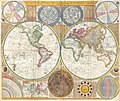Fitxategi:1794 Samuel Dunn Wall Map of the World in Hemispheres - Geographicus - World2-dunn-1794.jpg

Aurreikuspen honen neurria: 712 × 600 pixel. Bestelako bereizmenak: 285 × 240 pixel | 570 × 480 pixel | 912 × 768 pixel | 1.216 × 1.024 pixel | 2.431 × 2.048 pixel | 6.000 × 5.054 pixel.
Bereizmen handikoa ((6.000 × 5.054 pixel, fitxategiaren tamaina: 8,92 MB, MIME mota: image/jpeg))
Fitxategiaren historia
Data/orduan klik egin fitxategiak orduan zuen itxura ikusteko.
| Data/Ordua | Iruditxoa | Neurriak | Erabiltzailea | Iruzkina | |
|---|---|---|---|---|---|
| oraingoa | 22:01, 1 ekaina 2012 |  | 6.000 × 5.054 (8,92 MB) | Brandmeister~commonswiki | Reverted to version as of 04:17, 23 March 2011 |
| 18:15, 19 maiatza 2012 |  | 6.000 × 5.054 (27,38 MB) | Brandmeister~commonswiki | contrast | |
| 06:17, 23 martxoa 2011 |  | 6.000 × 5.054 (8,92 MB) | BotMultichillT | {{subst:User:Multichill/Geographicus |link=http://www.geographicus.com/P/AntiqueMap/World2-dunn-1794 |product_name=1794 Samuel Dunn Wall Map of the World in Hemispheres |map_title=A General Map of the World, or Terraqueouis Globe with all the New Discover |
Irudira dakarten loturak
Hurrengo orrialdeek dute fitxategi honetarako lotura:
Fitxategiaren erabilera orokorra
Hurrengo beste wikiek fitxategi hau darabilte:
- alt.wikipedia.org proiektuan duen erabilera
- ar.wikipedia.org proiektuan duen erabilera
- av.wikipedia.org proiektuan duen erabilera
- br.wiktionary.org proiektuan duen erabilera
- ckb.wikipedia.org proiektuan duen erabilera
- cv.wikipedia.org proiektuan duen erabilera
- de.wikipedia.org proiektuan duen erabilera
- en.wikipedia.org proiektuan duen erabilera
- Early world maps
- History of cartography
- Southern Ocean
- Samuel Dunn (mathematician)
- Wikipedia:Featured picture candidates/1794 Samuel Dunn Map
- A General Map of the World, or Terraqueous Globe
- Wikipedia:Featured picture candidates/June-2012
- User:Cruickshanks/sandbox2
- Wikipedia:Featured picture candidates/March-2014
- Wikipedia:Featured picture candidates/1794 Samuel Dunn Wall Map of the World in Hemispheres - Geographicus - World2-dunn-1794.jpg (review)
- User:Setvina/be bold
- Portal:Maps
- User:Sarangem
- User:Jacobwilder427
- en.wiktionary.org proiektuan duen erabilera
- eo.wikipedia.org proiektuan duen erabilera
- et.wikipedia.org proiektuan duen erabilera
- fa.wikipedia.org proiektuan duen erabilera
- ویکیپدیا:نگارههای برگزیده/نقشه
- ویکیپدیا:گزیدن نگاره برگزیده/ژوئن-۲۰۱۲
- نقشه ساموئل دان
- ویکیپدیا:گزیدن نگاره برگزیده/1794 Samuel Dunn Wall Map of the World in Hemispheres - Geographicus - World2-dunn-1794.jpg
- ویکیپدیا:نگاره روز/اکتبر ۲۰۱۲
- الگو:نر/2012-10-03
- الگو:نر محافظت شده/2012-10-03
- بحث کاربر:Alborzagros/بایگانی ۷
- fr.wikipedia.org proiektuan duen erabilera
- fr.wikiversity.org proiektuan duen erabilera
- gl.wikipedia.org proiektuan duen erabilera
- hu.wikipedia.org proiektuan duen erabilera
- hy.wikipedia.org proiektuan duen erabilera
- id.wikipedia.org proiektuan duen erabilera
Ikus fitxategi honen erabilpen global gehiago.


